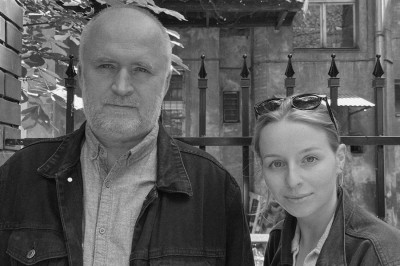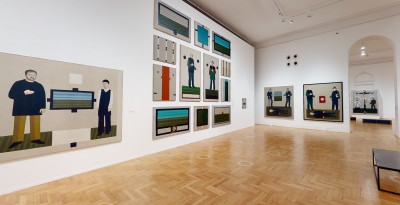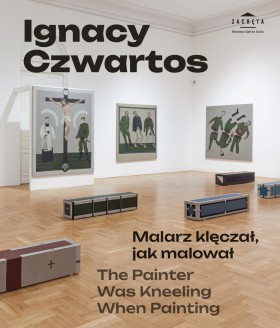Ignacy Czwartos The Painter Was Kneeling When Painting
24.02 – 28.05.2023 Ignacy Czwartos The Painter Was Kneeling When Painting
Zachęta – National Gallery of Art
curators : Janusz Janowski, Piotr Bernatowicz
Painting is one of those art forms where competition is especially strong. It is not an easy task to create one’s own idiom, one’s own unique and recognizable style. To say something truly significant in one’s painting is even more difficult. Ignacy Czwartos has succeeded on both counts.
His particular use of a spectrum of subtle shades of beige, different hues of white and soft blues, enriched with ‘muddy’ greens and dusky reds, goes well together with a harmonious rigidity of form, which manifests itself in his creations of wide, flat surfaces with parse objects or geometrical figures. All this makes the painter instantly recognizable when one comes across his work!
And yet his painting, however original and unique, is deeply rooted in the traditional art of old, as well as in the new or even contemporary. Ignacy Czwartos is not at all secretive about the sources of his inspiration — on the contrary, he has included portraits of many of his influences in his own paintings: Kazimir Malewicz, Mark Rothko, Andrzej Wróblewski, Nikifor Krynicki, Jerzy Nowosielski and Jarosław Modzelewski are all there. Some unnamed creators of old-Polish nobility coffin portraiture have also been a source of inspiration for Czwartos and he certainly acknowledges this debt to them through the style he uses for depicting them. Krystyna Czerni and other art critics see in Czwartos’s art a continuation of Polish baroque painting.
However, it is not the late period, theatrical baroque of the decorative ‘horror vacui’ type, but rather the indigenous, modest, early period Sarmatian baroque, which was often fascinated by and preoccupied with matters eternal. And so this dichotomy between life and death, as in the death dance commonly depicted in old art, is also a recognizable characteristic of Czwartos’s art, just as his unique style is. It is present in his most moving and at the same time most emotionally provocative cycle (shouldn’t art provoke emotions?) showing the so-called curse soldiers, who fought in the anti-communist underground after the war. Czwartos raises the tragic warriors from the dead and makes them keep guard in eternal adoration, or else depicts their fragile bodies, tortured by the security police, which are similar to the fragments of dead fish from the pictures by Andrzej Wróblewski. Czwartos is not ashamed of his influences, just as he is not ashamed of his heroes, and this is not always in tune with the current anti-hero mood.
In our times heroic deeds, be they shown in art or literature, are often met with derisive laughter. ‘The painter was kneeling when painting’, reads one of the comments on the internet. Should one take it as meaning to be serious about what one does, then yes, I was kneeling, Czwartos seems to be saying. Does not everyone kneel before something, does not everyone have their heroes? And what do we kneel before? Ignacy Czwartos’s art forces us to answer this question.
Ignacy Czwartos
The Painter Was Kneeling When Painting
24.02 – 28.05.2023
Zachęta – National Gallery of Art
pl. Małachowskiego 3, 00-916 Warsaw
See on the map
Godziny otwarcia:
Tuesday – Sunday 12–8 p.m.
Thursday – free entry
ticket office is open until 7.30 p.m.


